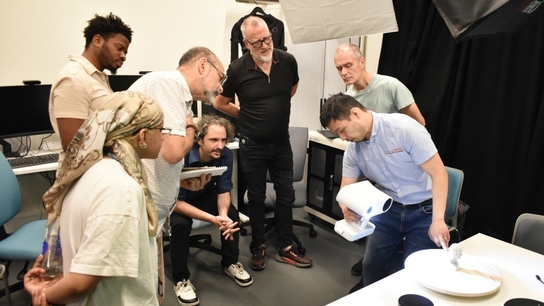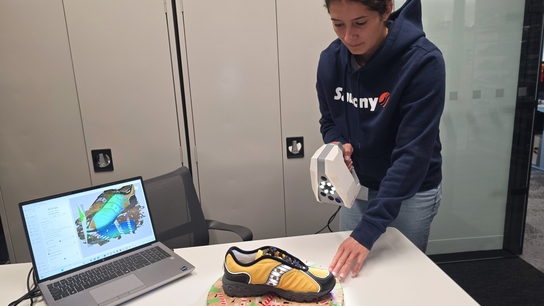Digitizing the frontiers of research: 3D scanning at hominid excavation sites in Kenya
The Goal: To use lightweight, handheld 3D scanners in remote locations, with a battery pack, scanning ancient fossils of various sizes under all kinds of weather conditions, quickly and easily, and then simply turn these scans into shareable 3D models for viewing and 3D printing.
Tools Used: Artec Eva, Artec Spider
Team Artec takes to Lake Turkana, Kenya to work alongside world-famous paleontologists 3D digitizing fossilized remains of prehistoric animals and hominids.
The Turkana Basin Institute (TBI) conducts research on our hominid ancestors and their surroundings near Kenya’s Lake Turkana. The remains anthropologists dig up are a vast source of information about life millions of years ago. By examining them, scientists can reconstruct our planet’s complex history and demystify the nature of life forms that once populated Earth.
TBI’s Louise Leakey explains, “Obviously the hominids, human ancestors represent 1% of all the different fossils that we find. We’re often more collecting pigs, horses, elephants, rodents and all sorts of other things which coexisted with our human ancestors.” For years, TBI has unearthed, studied, and preserved these sundry objects, adding immensely to the collection at Kenya’s National Museum.

Inside TBI’s research facility.
Meanwhile, as they locate more and more fossils, TBI continues to face challenges in their efforts to preserve, record, and publicize both old and new findings. Most techniques of preservation tend to run short of what scientists and researchers require to properly record raw data. For example, the use of photography to measure distances between objects to create three-dimensional models is prone to produce blurred images of bone morphology. 3D scanners, on the other hand, can capture images in higher resolution, generating high-quality visual data.
In August 2014, Artec’s expert scanning duo, Denis Baev and Francisco Correa, arrived at TBI’s facilities in Koobi Fora, north of Nairobi. There they got a first-hand look at the region’s fossils and learned about TBI’s challenges as preservationists. Denis and Francisco brought with them two of Artec’s star performers: Eva and Spider – powerful, handheld, high-resolution 3D scanners.
Like TBI fellows, Denis and Francisco kicked off their day at the break of dawn. The first leg of their trip brought them to Sibiloi National Park, an area known to contain a fossil collection of “prehistoric giants.” Nearly two million years ago, giant tortoises, crocodiles, and elephants wandered on this stretch of land.
The drive to the first excavation site lasted several bumpy hours – no roads, just tracks to follow. There Denis and Francisco came face to face with one of prehistory’s giant predators – well, only a fossilized piece of it.
Earlier Louise had instructed Team Artec on how to spot fossils by color, texture, and pattern. And after some adjustment to the way Denis and Francisco had been surveying the area, it became evident that fossils lay here, there, and pretty much everywhere!

Fossils at the Sibiloi National Park.
After thirty minutes, they managed to locate a massive fossilized crocodile skull propped up on rocks. Dating as far back as almost two million years ago, this prehistoric species probably feasted on unsuspecting mammals. Its enormous jaw suggests a diet of tough, fibrous meat.
When the team arrived, the ancient skull seemed changed. Seven years had passed since Louise last visited the site. Unlike other TBI findings, this skull did not have walls built around to protect it from the weather. Still, no weather condition could have tossed and turned this ten-pound fragment of history; someone had evidently disrupted it, and the damage was sadly irreversible. Nevertheless, we set about scanning what remained of the skull with Eva.

Using Artec Eva to scan the remains of a prehistoric crocodile.
A short distance away from the skull stood a building where a complete skeleton of another crocodile was kept. Denis immediately took to 3D capturing this unique find. He used Eva to scan the entirety of the skeleton, then our Spider to scan smaller, more detailed parts of the body. It took all but a brief twenty-minute session to digitize the prehistoric crocodile – a mere fraction of the time we had spent just trying to get to the excavation site!


Denis geared up and scanning with Artec Eva.
The result – a 3D image of the fossilized crocodile.
After scanning the crocodiles, Denis went off to snap a digital image of a giant tortoise. He saved the following day for the massive Elephas recki, a giant elephant similar to, but significantly larger than the modern-day Elephas maximus (Asian elephant).

While the size of fossils can make them difficult to move, they’re easy to scan on-site with Artec’s 3D imaging solutions.
Fossilized remains are a goldmine to scientists. But unlike the precious metal, which can be extracted with relative ease, these gigantic skeletal structures are simply too big and fragile to move. Moreover, fossils left at their site of discovery reveal much more to the scientists investigating both the objects and their surroundings. Indeed, keeping fossils where they were exhumed generates valuable contextual data that require experts in a variety of disciplines to unpack and understand. This is why TBI researchers need to collaborate closely with geologists and geneticists, among others.
But for interdisciplinary collaboration to happen, data culled from such remotely located sites, like Lake Turkana, need to be accessible. Thanks to advancements in 3D digital imaging, sharing and preserving research findings have become everyday practices for leading scientists.
For example, Louise and her team use Artec’s Eva and Spider practically every day. Sometimes they even demonstrate Artec’s scanners to visiting researchers, who later decide they need them for their own fieldwork. Currently, they are using Artec scanners to 3D scan fossil pieces that have been sitting in the museum collection.
TBI’s preservation efforts resemble some of Google’s Art Project to digitize artifacts. Google Art Project began in 2011 and acts as a virtual portal into the galleries of participating museums. It displays high-resolution images of some of the most prized possessions of the art world, featuring Artec Eva in its efforts to do so.

Excavated remains that still need to be 3D scanned.
TBI researchers believe that everyone should have easy access to the information they have accrued over years of fossil finding and cataloging near Lake Turkana. Unfortunately, cataloging in 3D digital form – let alone of those as complex, detailed, and textured as skull and teeth fragments – was technologically difficult and prohibitively expensive until recently. In our interview with Leakey, she shared her experience with using different techniques for digital image capturing: “I know that the scanners we were using before and obviously with photogrammetry, it’s… there’s only so much detail and how much accuracy you capture from that. Your handheld Artec scanners are actually very quick capturing, and it enables you to do a lot more than you could have done even just a couple years ago.”


1.9 million-year old skull of H. habilis that was 3D scanned with Artec Spider.
Artec Spider 3D captured the details and texture of this Paranthropus boisei mandible.
Artec’s 3D scanners help bring viewers face to face with ancient life. Their high-resolution capturing capabilities result in stunningly life-like digital replicas that can be stored, displayed online, or 3D printed. In addition, they offer their users speed, flexibility, portability, and ease of use. Leakey agrees, “To be able to have a replica of fossils on a computer and to be able to look at them. We’ve never been able to do that. It was a huge breakthrough to be able to capture that much detail. Now we’re able to scan in the middle of nowhere. Ideally, if we’d been able to scan, which we can do now, as we find something on the surface, as we excavate it, we can actually get detail day by day or hour by hour. You could actually document the whole process.” And with Artec’s unrivaled, long-lasting battery pack, documenting on-site away from energy sources for extended periods of time has become a definite possibility.

Just 30 minutes to scan and seamless post-processing with Artec’s auto align algorithm.
The realm of research, besides the field itself, has traditionally been confined to museum spaces and select laboratories around the world. This has kept fossilized objects in relative isolation from the public. TBI’s considerable collection had been no exception until recently. Museum and lab pieces seldom travel, but once digitally re-modeled, they can be infinitely replicated and distributed across the world at the click of a button. In this vein, 3D scanning has paved roads out of the cloisters of museums and labs, and introduced current research findings to the world of digital media.

3D rendered shell of a Giant Tortoise with measurement and annotation.
In fact, this was what inspired Louise to launch African Fossils, a website that virtualizes the laboratory experience at TBI. Using a combination of 3D capturing tools, including Artec 3D scanners, she now brings TBI’s research findings closer to home and laboratories across the world.
This kind of technology opens up new avenues for conversing about human history. In an interview with Artec, Louise affirms: “And so I felt we really had a chance now, if we began to scan the fossils not only as a digital record of the collections that are held in these more remote stations but to enable people anywhere in the world to explore and look at them in more detail.” Combine the imaging power of Artec scanners and the limitless reach of the Internet, and the geographic distances that stifle scientific dialog virtually disappear!
Scanners behind the story
Try out the world's leading handheld 3D scanners.






